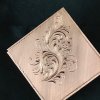Years ago I remember Alexandre Sidorov talking about switching to a coarse grit sharpening from his usual high polish sharpening, and finding that it extended the life of the graver. I also think Sam Welch might have agreed on that and used something similar. I wish I could find that old thread but I can't.
I've been sharpening to 1200 grit for several years with the exception of polished gravers for brightcutting precious metals, and 1200 suits me quite well and I feel I get good life from my gravers, although I'm not cutting much super hard stuff.
Comments?
I've been sharpening to 1200 grit for several years with the exception of polished gravers for brightcutting precious metals, and 1200 suits me quite well and I feel I get good life from my gravers, although I'm not cutting much super hard stuff.
Comments?









